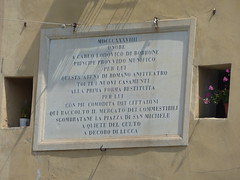

Carlo Lodovico di Borbone
(1799-1883)
King of Etruria (1803-1807), Duke of Lucca (1824-1847), and Duke of Parma (1847-1849)
Died aged 83
Wikidata WikipediaCharles Louis (Italian: Carlo Ludovico; 22 December 1799 – 16 April 1883) was King of Etruria (1803–1807; reigned as Louis II), Duke of Lucca (1824–1847; reigned as Charles I), and Duke of Parma (1847–1849; reigned as Charles II). He was the only son of Louis, Prince of Piacenza, and his wife Infanta Maria Luisa of Spain. Born at the Royal Palace of Madrid at the court of his maternal grandfather King Charles IV of Spain, he spent his first years living at the Spanish court. In 1801, by the Treaty of Aranjuez, Charles became Crown Prince of Etruria, a newly created kingdom formed from territories of the Grand Duchy of Tuscany. Charles moved to Italy with his parents and in 1803, not yet four years old, he succeeded his father as King of Etruria under the name Louis II. His mother Infanta Maria Luisa assumed the regency while Charles Louis' minority lasted. In 1807 Napoleon Bonaparte dissolved the kingdom of Etruria and Charles Louis and his mother took refuge in Spain. In May 1808 they were forced to leave Spain by Napoleon who arrested Charles Louis' mother in a convent in Rome. Between 1811 and 1814 Charles Louis was placed under the care of his grandfather, the deposed King Charles IV of Spain. After Napoleon's fall, in 1817, Infanta Maria Luisa became Duchess of Lucca in her own right and Charles Louis, age sixteen, became hereditary Prince of Lucca. In 1820 he married Princess Maria Teresa of Savoy. They were a mismatched couple and had only one surviving son. At his mother's death in 1824, Charles Louis became the reigning Duke of Lucca as Charles I. He had little interest in ruling. He left the duchy in the hands of his ministers and spent most of his time traveling around Europe. A liberal movement led him to abdicate Lucca in favor of the Grand Duke of Tuscany in October 1847 in exchange for financial compensation, as he wanted to retire to private life. Two months later, in December 1847, at the death of the former Empress Marie Louise, he succeeded her as the reigning Duke of Parma according to what had been stipulated by the Congress of Vienna. His reign in Parma as Duke Charles II was brief. He was ill-received by his new subjects and within a few months he was ousted by a revolution. He regained control of Parma under the protection of Austrian troops, but finally abdicated in favor of his son Charles III on 14 March 1849. His son was assassinated in 1854 and his grandson Robert I, the last reigning Duke of Parma, was deposed in 1860. In exile Charles Louis assumed the title of count of Villafranca. He spent the last years of his life mostly in France, dying at Nice on 16 April 1883.
DbPedia
Commemorated on 1 plaque
MDCCCXXXVIIII Onore A Carlo Lodovico di Borbone Principe Provvido Munifico Per Lui Questa Arena di Romano Anfiteatro Tolti I nuovi Casamenti Alla prima forma restituita Per lui Con piu comodita dei Cittadini Qui raccolto il mercato dei commestibili Sgombratane la Piazza di San Michele A quiete del culto A decoro di Lucca
English translation: 1839 Honour To Carlo Lodovico di Borbone Principe Provide Munific For Him This Arena of Roman Amphitheatre Removed The new Casamenti The first form returned For him With more comfort of the Citizens Here collected the market of edible Sgombratane the Piazza di San Michele A quiet cult A decorum of Lucca
Piazza Anfiteatro, Lucca, Italy where they was honoured (1839)
